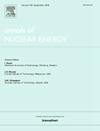熔氯快堆上Cl-35核数据的不确定度量化
IF 1.9
3区 工程技术
Q1 NUCLEAR SCIENCE & TECHNOLOGY
引用次数: 0
摘要
本文研究了35Cl核数据不确定性对熔融氯化物快堆(MCFR)中子电子学的影响,重点研究了MCFR- c和MCFR- d两种模型。利用蒙特卡罗代码SERPENT2,对初始和平衡燃料成分进行了全面的灵敏度分析和不确定度量化。这项研究是与洛斯阿拉莫斯国家实验室的核数据评估人员同步完成的,他们正在对35Cl进行新的评估。这些发现表明,新的35Cl评估对这些设计的核心中子电子学的影响最小(但可能对不同的通量谱产生重大影响),但显著降低了有效中子倍增因子(keff)的不确定性到~ 1000 pcm(从~ 1400 pcm)。结合蒙特卡罗统计不确定性和核协方差正半定校正算法,开发了一种鲁棒的方法和工作流,通过SERPENT的灵敏度分析来传播不确定性。尽管受到大量计算时间和内存使用的限制,该方法为不确定性传播提供了可靠的方法,为MCFR- c和MCFR- d反应堆的静态和不确定性参数提供了有价值的见解,从而有助于MCFR技术的进步。它还提供了一个有价值的例子,说明下游应用中子学如何与核数据评估人员一起工作,以改进反应堆分析。本文章由计算机程序翻译,如有差异,请以英文原文为准。
Uncertainty quantification of Cl-35 nuclear data on a Molten Chloride Fast Reactor
This study investigates the impact of 35Cl nuclear data uncertainties on the neutronics of Molten Chloride Fast Reactors (MCFR), specifically focusing on two models: MCFR-C and MCFR-D. Using the Monte Carlo code SERPENT2, a comprehensive sensitivity analysis and uncertainty quantification was conducted for both initial and equilibrium fuel compositions. This study was done synchronously with nuclear data evaluators at Los Alamos National Laboratory who were creating a new evaluation for 35Cl. These findings reveal that the new 35Cl evaluation has minimal effect on core neutronics for these designs (however could have a significant impact for a different flux spectrums), but significantly reduces the uncertainty in the effective neutron multiplication factor () to 1000 pcm (from 1400 pcm). A robust method and workflow was developed to propagate uncertainties through SERPENT’s sensitivity analysis, incorporating the Monte Carlo statistical uncertainties and using a Positive Semi-Definite correction algorithm for nuclear covariance data. Though limited by significant computational time and memory usage, this approach offers a reliable method for uncertainty propagation offering valuable insights into the static and uncertainty parameters of MCFR-C and MCFR-D reactors, thereby contributing to the advancement of MCFR technology. It also provides a valuable example of how downstream applied neutronics can work together with nuclear data evaluators to improve reactor analyses.
求助全文
通过发布文献求助,成功后即可免费获取论文全文。
去求助
来源期刊

Annals of Nuclear Energy
工程技术-核科学技术
CiteScore
4.30
自引率
21.10%
发文量
632
审稿时长
7.3 months
期刊介绍:
Annals of Nuclear Energy provides an international medium for the communication of original research, ideas and developments in all areas of the field of nuclear energy science and technology. Its scope embraces nuclear fuel reserves, fuel cycles and cost, materials, processing, system and component technology (fission only), design and optimization, direct conversion of nuclear energy sources, environmental control, reactor physics, heat transfer and fluid dynamics, structural analysis, fuel management, future developments, nuclear fuel and safety, nuclear aerosol, neutron physics, computer technology (both software and hardware), risk assessment, radioactive waste disposal and reactor thermal hydraulics. Papers submitted to Annals need to demonstrate a clear link to nuclear power generation/nuclear engineering. Papers which deal with pure nuclear physics, pure health physics, imaging, or attenuation and shielding properties of concretes and various geological materials are not within the scope of the journal. Also, papers that deal with policy or economics are not within the scope of the journal.
 求助内容:
求助内容: 应助结果提醒方式:
应助结果提醒方式:


